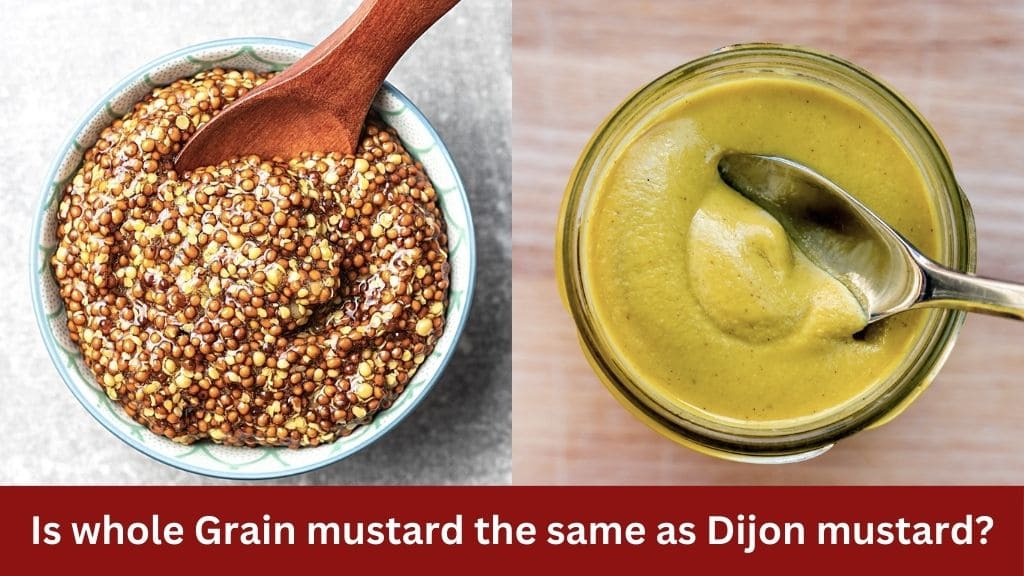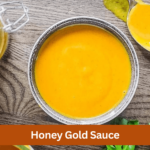When it comes to condiments, mustard often stands out as a versatile and flavorful option. Among the various types of mustard available, whole grain mustard and Dijon mustard are commonly found in kitchens worldwide. But are they really the same thing? In this comprehensive blog post, we’ll delve into the similarities and differences between whole grain mustard and Dijon mustard to uncover the truth behind these popular condiments.
Mustard, derived from the mustard plant’s seeds, has been a culinary staple for centuries. It adds depth, tanginess, and complexity to dishes, making it a favorite among chefs and home cooks alike. However, within the realm of mustard, there exist variations in preparation, flavor, and texture, leading to distinctions between different types such as whole grain mustard and Dijon mustard.
Origins and History
Whole Grain Mustard
:max_bytes(150000):strip_icc()/__opt__aboutcom__coeus__resources__content_migration__serious_eats__seriouseats.com__recipes__images__2012__04__20120401-199820-whole-grain-dijon-ac842655f4c84b87b967ddd2009cd6cd.jpg)
Whole grain mustard, also known as coarse mustard or stone-ground mustard, has a relatively recent history compared to its counterparts. It is believed to be an American invention, with early mentions dating back to the 1980s. The exact origins of whole grain mustard are somewhat obscure, with no definitive record of its creation. However, its emergence can be attributed to a growing interest in artisanal and gourmet foods during the latter half of the 20th century.
While mustard has been consumed for centuries in various forms, the concept of preserving mustard seeds in their whole state and incorporating them into a condiment is a relatively modern innovation. Whole grain mustard gained popularity for its unique texture and mild flavor, making it a versatile addition to various dishes, including sandwiches, dressings, and sauces.
Dijon Mustard
:max_bytes(150000):strip_icc()/dijon-mustard-transform-your-cooking-getty-0124-a2f351e21672442e8666aafc1d0a164e.jpg)
Dijon mustard boasts a much older lineage with roots tracing back to 18th-century France. Originating in the city of Dijon, located in the Burgundy region, this mustard variety was first crafted by two entrepreneurs, Auguste Poupon and Maurice Grey. The duo’s innovative approach to mustard-making revolutionized the condiment industry, paving the way for Dijon mustard to become synonymous with French cuisine.
The name “Dijon mustard” is derived from the city of Dijon, where the condiment gained widespread popularity and acclaim. Over the centuries, Dijon mustard has become an integral part of French culinary tradition, featuring prominently in regional dishes and haute cuisine. Its smooth texture and bold flavor profile have earned it a place on tables around the world, solidifying its status as a culinary icon.
While the exact recipe for Dijon mustard has evolved over time, the core ingredients typically include ground brown mustard seeds, vinegar or wine, salt, and various spices. The combination of these ingredients produces a creamy and pungent mustard paste that adds depth and complexity to a wide range of dishes.
Ingredients and Preparation
Whole Grain Mustard

Whole grain mustard is crafted using whole and lightly ground mustard seeds, which give it a distinctive texture and appearance. The process begins with selecting high-quality mustard seeds, typically a combination of yellow and brown varieties, known for their robust flavor profiles. These seeds are then mixed with vinegar, salt, and often other spices or flavorings, such as garlic, herbs, or honey, to enhance the condiment’s taste complexity.
The key characteristic of whole grain mustard lies in its coarse texture, achieved by leaving the mustard seeds whole or only lightly ground during the preparation process. This results in a chunky consistency with visible specks of mustard seeds throughout the condiment. The mixture is then allowed to mature and develop its flavors over time, with some variations aged in barrels for added depth.
The simplicity of its preparation and the use of natural, unprocessed ingredients contribute to whole grain mustard’s appeal among chefs and food enthusiasts. Its rustic charm and subtle tanginess make it a versatile addition to various culinary creations, from sandwiches and salads to marinades and glazes.
Dijon Mustard

In contrast, Dijon mustard is crafted using finely ground brown mustard seeds, which are known for their intense flavor and spiciness. The mustard-making process begins with selecting premium mustard seeds, which are then finely ground to create a smooth and creamy mustard paste. The ground seeds are combined with vinegar or wine, salt, and other seasonings, such as white wine, spices, or herbs, to achieve the desired flavor profile.
One of the defining characteristics of Dijon mustard is its silky texture, resulting from the thorough grinding of the mustard seeds and the emulsification of the ingredients. The mustard paste is typically aged for a period of time to allow the flavors to meld and mellow, resulting in a balanced and nuanced condiment.
The meticulous attention to detail and the use of high-quality ingredients contribute to Dijon mustard’s reputation as a gourmet condiment. Its bold flavor and smooth consistency make it a preferred choice for sauces, dressings, and condiments in both home kitchens and professional culinary settings.
Flavor Profile
Whole Grain Mustard
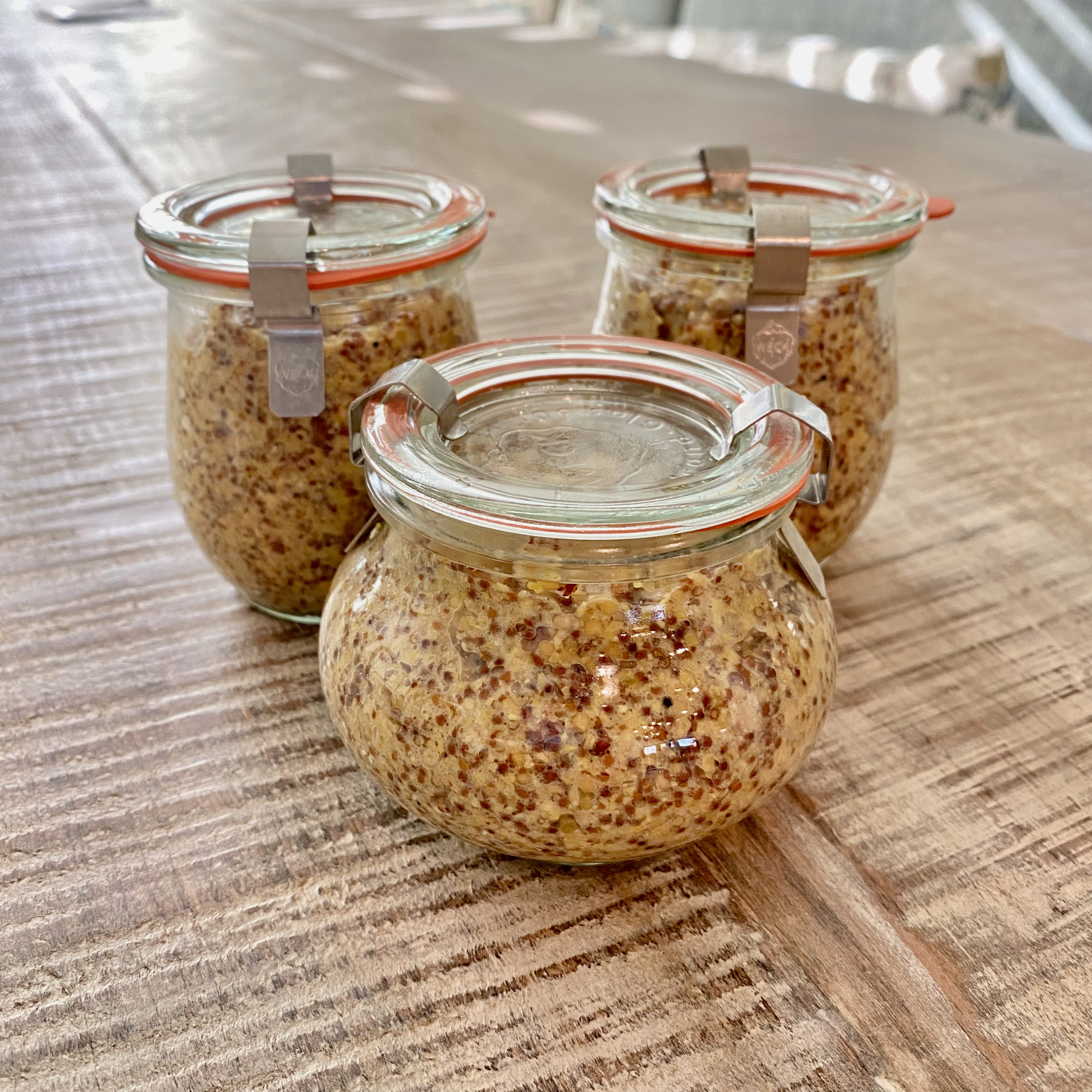
Whole grain mustard offers a nuanced and multifaceted flavor profile characterized by its mild tanginess and subtle spiciness. The presence of whole or lightly ground mustard seeds imparts a distinctive earthy and nutty undertone to the condiment, adding depth and complexity to dishes. The vinegar used in its preparation provides a gentle acidity that balances the mustard’s natural pungency, resulting in a harmonious flavor profile.
One of the key attributes of whole grain mustard is its mildness compared to other mustard varieties. The absence of thorough grinding preserves the mustard seeds’ natural oils and nuances, resulting in a less intense flavor profile. As a result, whole grain mustard is often favored for its ability to enhance dishes without overpowering other ingredients, making it a versatile option for culinary creations.
The coarse texture of whole grain mustard also contributes to its flavor profile, providing a satisfying crunch and mouthfeel that adds interest to dishes. The visible specks of mustard seeds throughout the condiment offer visual appeal and hints at the condiment’s artisanal craftsmanship.
Dijon Mustard
:max_bytes(150000):strip_icc()/SRDijonMustardPhotosSPV6of11-444fc06390944ce6aa125c4ec56b503e.jpg)
In contrast, Dijon mustard boasts a bold and assertive flavor profile characterized by its intense spiciness and tanginess. The finely ground brown mustard seeds used in its preparation release enzymes that enhance the mustard’s natural pungency, resulting in a sharper and more pronounced flavor profile. The vinegar or wine used in its formulation adds a bright acidity that cuts through rich flavors, making Dijon mustard a popular choice for pairing with meats, cheeses, and other robust ingredients.
One of the defining characteristics of Dijon mustard is its versatility in enhancing the flavors of dishes. Its bold and complex taste profile allows it to stand up to strong flavors, making it an ideal ingredient for sauces, marinades, dressings, and condiments. Whether used as a spread on sandwiches, a dip for pretzels, or a base for salad dressings, Dijon mustard adds depth and dimension to a wide range of culinary creations.
Culinary Applications
Whole Grain Mustard
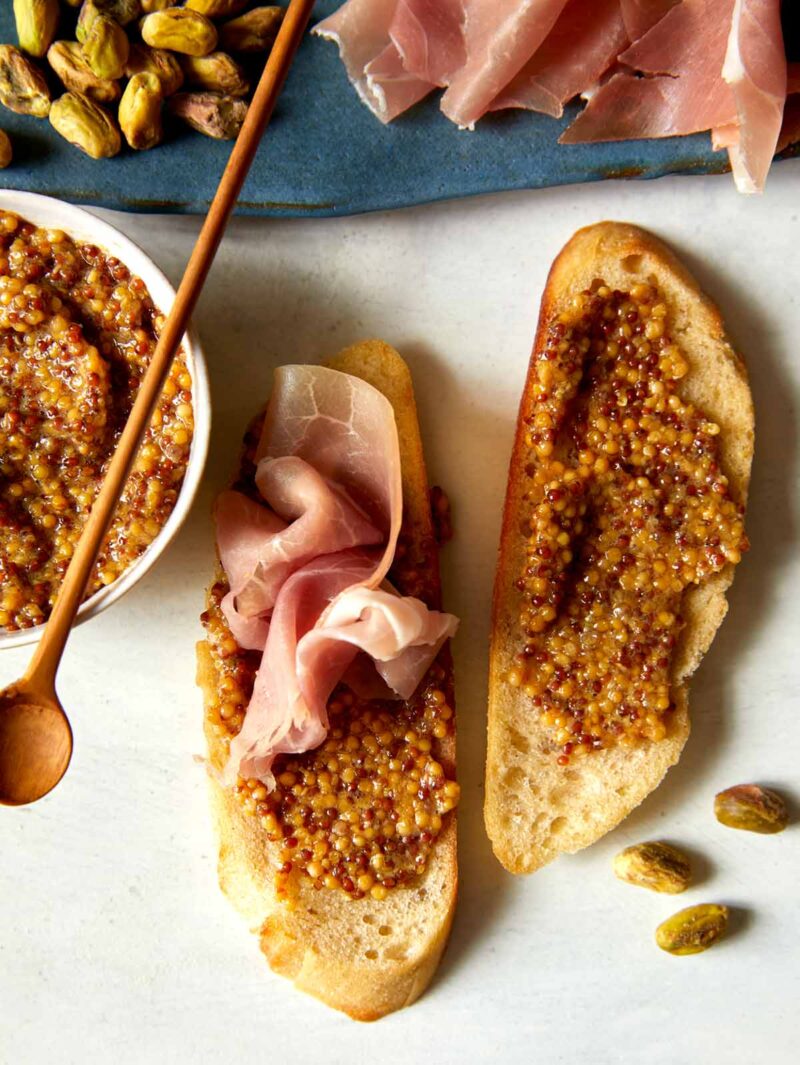
Whole grain mustard’s unique texture and mild flavor make it a versatile ingredient in various culinary applications. Here are some common ways to incorporate whole grain mustard into your cooking:
- Sandwiches: Spread whole grain mustard onto sandwiches, burgers, or wraps for added flavor and texture. It pairs well with a variety of fillings, including deli meats, cheeses, and vegetables, adding depth and complexity to each bite.
- Salads: Use whole grain mustard as an ingredient in salad dressings or vinaigrettes to add tanginess and depth to your salads. Its chunky texture can help emulsify the dressing and provide a satisfying crunch.
- Marinades and Glazes: Incorporate whole grain mustard into marinades or glazes for meats, poultry, or seafood. Its mild flavor and coarse texture help tenderize proteins and infuse them with delicious flavor during cooking.
- Charcuterie Boards: Include whole grain mustard as a condiment on charcuterie boards or cheese platters. Its rustic appearance and nuanced flavor complement a variety of cured meats, cheeses, and accompaniments, enhancing the overall dining experience.
- Dips and Spreads: Mix whole grain mustard with mayonnaise, sour cream, or Greek yogurt to create flavorful dips and spreads. Serve with crudites, crackers, or breadsticks for a delicious appetizer or snack option.
Dijon Mustard

Dijon mustard’s bold flavor and smooth consistency make it a favorite among chefs for a wide range of culinary applications. Here are some popular ways to use Dijon mustard in your cooking:
- Sauces and Dressings: Incorporate Dijon mustard into sauces and dressings to add depth and complexity to your dishes. It pairs well with creamy ingredients like mayonnaise or yogurt, as well as acidic components like lemon juice or vinegar, creating a balanced and flavorful sauce or dressing.
- Marinades: Use Dijon mustard as a key ingredient in marinades for meats, poultry, or vegetables. Its bold flavor and emulsifying properties help tenderize proteins and infuse them with savory goodness before cooking.
- Condiments: Serve Dijon mustard as a condiment alongside grilled meats, sausages, or sandwiches. Its intense flavor and smooth texture complement a variety of savory dishes, adding a burst of tanginess and spice with each bite.
- Egg Dishes: Incorporate Dijon mustard into egg dishes such as deviled eggs, omelets, or quiches for added flavor and depth. Its zesty taste profile enhances the savory notes of eggs, creating a delicious and satisfying breakfast or brunch option.
- Baking: Use Dijon mustard as a flavor enhancer in baked goods such as bread, pretzels, or savory pastries. Its tangy flavor adds complexity to the dough, while its emulsifying properties help create a tender and moist texture in the finished product.
Substitution and Usage
Whole Grain Mustard as a Substitute
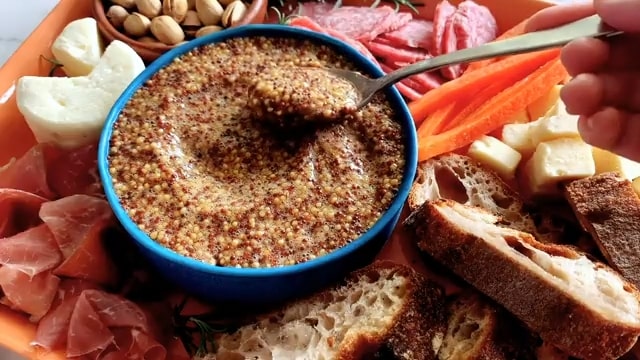
Whole grain mustard can serve as a suitable substitute for Dijon mustard in certain culinary scenarios:
- Milder Flavor: If you prefer a milder flavor profile, whole grain mustard can be used in place of Dijon mustard. Its gentle tanginess and subtle spiciness make it an excellent choice for dishes where a less assertive mustard flavor is desired.
- Chunky Texture: Whole grain mustard’s coarse texture adds visual interest and mouthfeel to dishes. It works well in recipes where a chunkier consistency is desired, such as salad dressings, marinades, or spreads.
- Visual Appeal: Whole grain mustard’s speckled appearance adds visual appeal to dishes, particularly when used as a condiment or garnish. It can enhance the presentation of cheese boards, charcuterie platters, or sandwiches, making them more visually appealing and appetizing.
However, there are limitations to using whole grain mustard as a substitute for Dijon mustard:
- Smooth Consistency: Whole grain mustard’s chunky texture may not be suitable for recipes that require a smooth consistency, such as creamy sauces or dressings. In such cases, whole grain mustard can be blended or strained to achieve a smoother texture, but the resulting flavor may differ slightly from that of Dijon mustard.
Dijon Mustard as a Substitute

Conversely, Dijon mustard can also be used as a substitute for whole grain mustard in certain culinary applications:
- Stronger Flavor: Dijon mustard’s bold and assertive flavor profile makes it a suitable substitute for whole grain mustard when a stronger mustard flavor is desired. Its intense spiciness and tanginess can enhance the overall flavor of dishes, particularly those with rich or savory ingredients.
- Smooth Consistency: Dijon mustard’s smooth texture makes it ideal for recipes that require a uniform consistency, such as sauces, dressings, or dips. Its emulsifying properties help create creamy and velvety textures, enhancing the mouthfeel of dishes.
However, there are considerations to keep in mind when using Dijon mustard as a substitute for whole grain mustard:
- Dominant Flavor: Dijon mustard’s bold flavor may overpower more delicate ingredients in certain recipes. It’s essential to adjust the amount of Dijon mustard used to ensure that it complements, rather than overwhelms, the other flavors in the dish.
- Texture: Dijon mustard’s smooth consistency may not provide the same textural contrast as whole grain mustard. While it can still add flavor to dishes, the absence of whole mustard seeds may result in a less dynamic mouthfeel.
Conclusion
While whole grain mustard and Dijon mustard share commonalities as mustard-based condiments, they differ significantly in terms of texture, flavor, and culinary applications. Whole grain mustard offers a mild yet textured experience, ideal for adding depth to dishes, while Dijon mustard delivers a bold and creamy profile, perfect for enhancing flavors in various recipes. Understanding the distinctions between these two varieties allows cooks to make informed choices and experiment with flavors in the kitchen. Whether it’s the coarse crunch of whole grain mustard or the smooth richness of Dijon mustard, both offer unique culinary experiences worth exploring.

